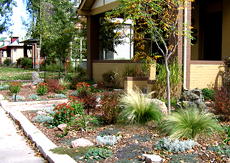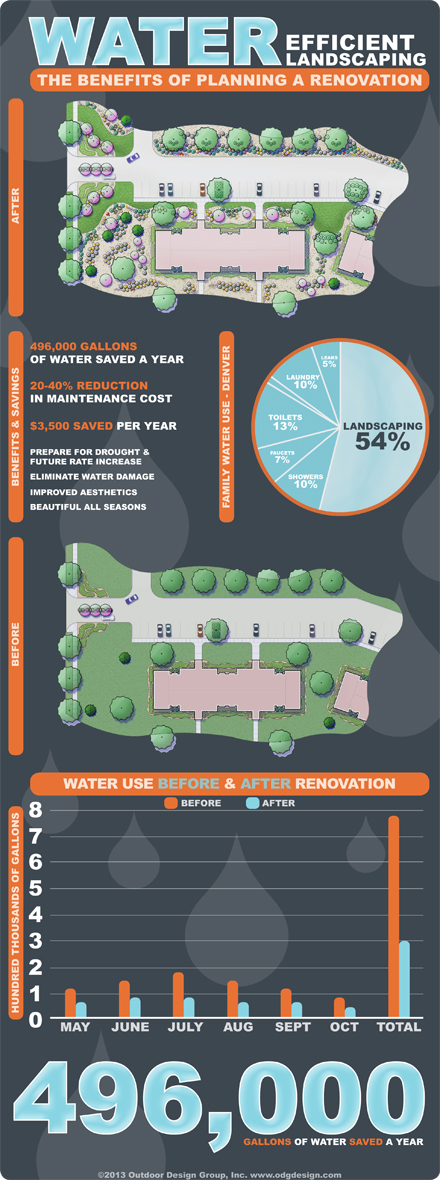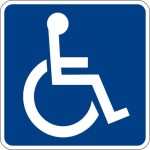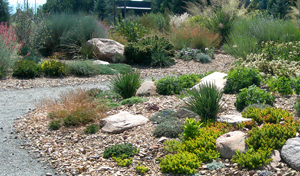by Matt Corrion
1) Ditch the bluegrass turf lawn, completely or partially. Bluegrass turf uses far more water than alternative landscaping choices.
2) Set your mower on its highest setting so turf grass is not cut too short. Longer grass keeps the soil cooler and reduces evaporation.

Consider redesigning your landscape so it requires less water and looks more interesting
3) Use the mulch setting on your lawn mower so grass clippings stay on the lawn, which helps slow evapotranspiration and provides nutrients to the soil.
4) Do not install bluegrass turf on slopes, especially south facing slopes, because much of the water will run off the slope and sprinklers will need to run for longer times to compensate. Instead consider planting shrubs or native plants with drip irrigation on a slope.
5) Mulch your trees, shrubs and perennials to reduce water use. Mulch slows down the evaporation of soil moisture, reduces water run-off, and reduces weeds which can steal moisture from your plants.
6) Consider replacing your existing high-water turf lawn with low-water turf options such as buffalo grass, blue grama grass or a fescue grass.
7) Plant native plants that are more appropriate for the climate you live in.
8) If you plant non-native plants, use ones that are adapted to your climate conditions, such as iceplant from South Africa, and Russian sage from Central Asia.
9) Place your plants in groups organized by water use, so as to avoid overwatering low water need plants.
10) Plant trees in your turf lawn to provide shade for the lawn and reduce evapotranspiration of the grass.
11) Follow your water provider’s summer watering rules, and any watering restrictions that may be in place at that time.
12) Don’t water during the hottest time of the day. It is best to water between 6 pm and 10 am. Watering during the hottest time of the day increases the evaporation of the water before it reaches the roots of your plants.
13) Don’t water when it is windy. Just as watering during the hottest time of day increases water loss due to increased evaporation, so does watering when it is windy.
14) When shoveling snow in winter, place snow piles where it will melt and water trees and shrubs that can benefit from extra moisture in winter.
15) Install a rain sensor to avoid having your irrigation system run when it is raining, or the day after a heavy rainfall event.
16) If you don’t have an automatic irrigation system, use a mechanical or digital timer with your sprinklers.
17) If you have an automatic irrigation system, check it once a month or more often to fix any leaks or problems that may occur.
18) Use drip irrigation to water your landscape plants. Drip irrigation is the most efficient form of irrigation because the water is not sprayed into the air which increases evaporation of the water before it reaches the plants.
19) Avoid placing sprinkler heads against fences and hardscape. Instead, install a strip of rock mulch between fences / hardscape and sprinkler heads. In addition to reducing water waste, this minimizes water damage and the need for turf edge trimming.
20) Improve your soils water holding capacity by amending the soil with organic matter.
21) Make your landscape more permeable to keep storm water on your property. Instead of a solid concrete patio, install a unit paver patio to allow water to percolate down rather than running off.
22) Divide watering times into shorter shifts to improve water absorption, and avoid runoff. This is sometimes referred to as the “cycle and soak” method.
23) Direct gutter downspouts to planted areas rather than streets or storm water areas.
24) Save rainwater from your roof for irrigating plants.
25) Save indoor “grey” water for irrigating trees and shrubs.
26) If local codes allow, hire a plumber (or DIY) to pipe your grey water to your landscaping.
27) Use a mild/natural dish soap for washing dishes to keep this grey water safer for your landscape plants.
28) Bathe your pets outside over turf areas that need water, using mild/natural soap.
29) Wash fruits and vegetables outside over your lawn to allow wash water to irrigate the turf.
30) Plant trees (adapted for your climate) to shade your turf area to reduce evapo-transpiration of the turf.
31) Consult a landscape architect or horticulturalist to learn the best plants to use in your climate and growing zone.
32) Before planting certain species of plants, do extensive soil preparations. Some plants benefit from additional organic matter, while others will perform better if drainage is improved.
33) Save fallen leaves in autumn and use as a mulch around trees, shrubs and perennials.
34) Plant new perennials, shrubs and trees in fall when temperatures are cooler because it will take less water to establish them, as compared to planting in early summer.
35) Cover water features, pools and spas when not in use to reduce evaporation.
36) Check water features, pools and spas for leaks.
37) Consider using pondless water features, where the water reservoir is hidden or obscured which provides less evaporation that a typical pond.
38) Don’t use water to clean paving. Use a broom and dust pan.
39) If you want to install a water feature, choose one that cascades or trickles rather than one that sprays in the air. Spraying fountains lose more water to evaporation.
40) If your children want to play in the sprinkler, have them do this in an area of your lawn that needs water.
41) Do not let your children waste water by spraying sprinklers on sidewalks, drive ways or the street.
42) Place large rocks near shrubs, trees or perennials to keep the soil below the rock cool and moist.
43) When refreshing your pet’s water dish, don’t discard the old water in the sink, pour it on plants outside.
44) If you have ice or water left in a take-out cup, or in re-usable glasses, pour it on your landscape plants outside.
45) Don’t discard used ice and water from a cooler in the sink, but throw them outside on your plants.
46) If you wash your car at home with a hose, use a shut-off nozzle so water is not running in between soaping and rinsing the car.
47) Wash the car in a lawn area so that you water the grass at the same time. Use a mild/natural detergent when doing this.
48) Don’t use a hose to clean out your gutters. Consider using a leaf blower or a long handled rake specifically made for the job.
49) Replace old spray nozzles on your irrigation system with newer, more efficient rotary nozzles. They reduce runoff and evaporation. Your purchase and installation of these nozzles may make you eligible for rebates from your water provider. Contact them for more details.
50) Consider hiring a landscape architect to analyze your property and re-design it to require less water and maintenance.
This is the official blog of Outdoor Design Group, Colorado Landscape Architects. For more information about our business and our services, click here.
Related Posts:
by Matt Corrion

This is the official blog of Outdoor Design Group, Colorado Landscape Architects. For more information about our business and our services, click here.
Related Posts:
by Matt Corrion
On March 15, 2012, facilities across the United States must comply with the revised ADA (Americans with Disabilities Act) design standards adopted in the 2010 Standards for Accessible  Design.
Design.
The 2010 Standards set minimum requirements for newly designed and constructed or altered State or local government facilities, public accommodations, and commercial facilities to be readily accessible to and usable by individuals with disabilities.
I have reviewed the new standards, and they are pretty extensive. Property owners and designers should be aware of some of the changes that will be required when constructing or altering a facility.
The provision requiring accessible means of entry/exit for swimming pools has gained a lot of attention. On March 15th, the US Attorney General signed an extension of 60 days for this particular provision, while also opening up a public comment period.
The swimming pool provision, along with other key new provisions, as taken from the ADA website, include:
2. Recreational Boating Facilities (Sections 235, 1003)
If boat slips are provided at a boating facility, the minimum number that must be accessible depends upon the size of the facility. Accessible boat slips must be dispersed throughout the various types of boat slips.
Where boarding piers are provided at boat launch ramps, at least 5% (but no fewer than one) must be accessible. Gangways that are part of a required accessible route are to be accessible, subject to certain enumerated exceptions.
4. Fishing Piers and Platforms (Sections 237, 1005)
Newly designed, newly constructed, or altered fishing piers must provide accessible routes, subject to the same exceptions permitted for gangways. At least 25% of guardrails or handrails must be no higher than 34 inches and must be dispersed. Clear floor or ground space must be provided at each accessible railing, and turning space must be provided on the pier.
5. Golf Facilities (Sections 238, 1006)
Newly constructed and altered golf facilities must have either an accessible route or golf car passages with a minimum width of 48 inches connecting accessible elements and spaces within the boundary of the golf course. An accessible route must be provided to the golf car rental area, bag drop-off areas, and other elements that are outside the boundary of the golf course. One or two teeing grounds (depending on the total number provided) per hole must be accessible.
If weather shelters are provided, a golf car must be able to enter and exit the shelters. Certain percentages of practice teeing grounds, practice teeing stations at driving ranges, and putting greens must be accessible.
6. Miniature Golf (Sections 239, 1007)
At least fifty percent of all holes on a miniature golf course must be accessible. These accessible holes must be consecutive, and they must be on an accessible route. The last accessible hole must be on an accessible route that connects to the course entrance or exit without going back through other holes.
7. Play Areas (Sections 240, 1008)
Play areas designed, constructed, and altered for children ages two and over in a variety of settings, including parks, schools, childcare facilities, and shopping centers, are covered.
Accessible ground and elevated play components, accessible routes, ramps and transfer systems (typically a platform or transfer steps), and accessible ground surfaces must be provided.
8. Swimming Pools, Wading Pools, and Spas (Sections 242, 1009)
Accessible means of entry/exit are required for swimming pools. Such accessible means of entry include a pool lift or sloped entry, and either a transfer wall, transfer system, or pool stairs. Wading pools must provide a sloped entry, and spas must provide a pool lift, transfer wall, or transfer system. Wave action pools, leisure rivers, and sand bottom pools where user access is limited to one area shall not be required to provide more than one accessible means of entry, either a pool lift, sloped entry, or a transfer system.
This is the official blog of Outdoor Design Group, Colorado Landscape Architects. For more information about our business and our services, click here.
Related Posts:
by Matt Corrion
You may have heard that you can save big bucks on water and maintenance by renovating your landscaping to be more water-efficient.

But, did you know that Cities across the country will pay you cash to do it?
As water supplies dwindle and populations rise, many municipalities are offering great incentives for reducing water use in the landscape. When property owners, businesses, or managers factor in the payback from these rebates along with the water and maintenance savings, a landscape renovation can make a lot of sense.
The 2 Main Types of Rebates
Generally speaking, incentives for reducing water use fall into two categories. The first category is paying customers to remove landscapes that have high water use and replace them with attractive low water use plantings, and the second category is to provide rebates for purchasing and installing irrigation components that reduce water use and that are more efficient than older systems.
As we have discussed in the past, the real water savings (as well as the largest rebates) come from replacing high water use lawns and landscaping, with new plantings that require less water and are more adapted to the local climate. There are many benefits to this approach- see The Top 10 Benefits of Making Landscaping More Water Efficient.
14 Specific Examples of Rebate Programs
Incentives for Removing Turf: $0.75 per square foot for single family homes and multi-family or commercial properties.
Equipment Rebates: Rebates for smart controllers, rain sensors, rotary nozzles, and equipment for removing sod and placing compost.
Additional Program Notes: Rebates of up to $150.00 are also offered for rainwater collection systems, and with the installation of a rainwater collection system the incentives double to $1.50 per square foot. Residents may also receive a $20.00 credit for attending a water efficiency class.
Equipment Rebates: Rebates for smart water controllers, weather sensors, and moisture sensors for single homes and multi-family or commercial properties.
Additional Program Notes: Rebates include 50% of the purchase price for valves, and $75.00 per drip zone installed.
Incentives for Removing Turf: $1.00 per square foot, up to $10,000 for single family homes, and up to $25,000 for multi-family or commercial properties.
Additional Program Notes: Rebates are also available for removing old hardscapes, and for seeding areas with native grasses.
Incentives for Removing Turf: $18.50 per 1,000 gallons of water saved for multi-family or commercial properties.
Equipment Rebates: Single family residential customers can receive $2.00 per efficient nozzle and $100.00 for weather-based smart controllers with rain sensors. Multi-family or commercial properties can receive $2.00 per efficient nozzle, and 25% of the cost of a smart controller.
Equipment Rebates: Single family residential customers can receive up to $1,000 for installing smart controllers and rain sensors. Multi-family or commercial properties can receive up to $5,000 for installing smart controllers and rain sensors.
Additional Program Notes: Rebates are also available for rotary nozzles, mpr spray heads, pressure reducing drip valves, and backflow prevention devices specifically made for drip systems.
Incentives for Removing Turf: $0.25 per square foot for installing drought tolerant Buffalo Grass for single family homes and multi-family or commercial properties.
Equipment Rebates: Rebates of $50.00 for moisture sensors, and 50% of the purchase price of a drip irrigation system are available for single family homes and multi-family or commercial properties.
Equipment Rebates: Single family residential customers can receive up to $550.00 for installing smart controllers, rain sensors, and rotary nozzles. Multi-family or commercial properties can receive up to $3,550.00 for installing smart controllers, rain sensors, and rotary nozzles.
Additional Program Notes: Rotary nozzle rebates are available for up to $200.00 for single family residential, and up to $2,000 for multi-family or commercial properties. Rebates are available for 50% of the purchase price of smart controllers and rain sensors.
Incentives for Removing Turf: Rebates of up to $1,650 are available for single family homes and multi-family or commercial properties.
Equipment Rebates: Rebates of up to $250.00 are available for installing smart controllers.
Incentives for Removing Turf: Up to $3,000 for single family homes and multi-family or commercial properties.
Equipment Rebates: Single family residential customers can receive up to $250.00 for installing smart controllers. Multi-family or commercial properties can receive up to $1,250.00 for installing smart controllers.
Additional Program Notes: A minimum area of 1,000 square feet of turf must be removed to qualify for turf removal incentives.
Incentives for Removing Turf: $1.50 to $1.00 per square foot, up to $300,000 for single family and multi-family or commercial properties.
Equipment Rebates: 50% of the cost of smart controllers, and $25.00 for rain sensors for single family and multi-family or commercial properties.
Incentives for Removing Turf: $1.50 per square foot up to $3,000 for single family homes, and $1.50 per square foot up to $9,000 for multi-family or commercial properties.
Equipment Rebates: Single family residential customers can receive up to $400.00 for installing smart controllers. Multi-family or commercial properties can receive $25.00 per station up to 68 stations ($1,700) for installing a smart controller.
Additional Program Notes: Rebates of $0.50 for every gallon of storage capacity up to 400 gallons are offered for rainwater collection systems.
Incentives for Removing Turf: $0.75 per square foot up to $2,000 is available for for single family homes, and $0.75 per square foot up to $20,000 is available for multi-family or commercial properties.
Equipment Rebates: Rebates are available for smart controllers, rain sensors, rotary nozzles, and dedicated landscape meters.
Additional Program Notes: Rebates of $1.50 per square foot up to $30,000 are also available for commercial properties through a “cost sharing areas” program.
Equipment Rebates: Single family residential customers can receive up to $375.00 in equipment rebates. Multi-family properties can receive up to $500.00 for new equipment.
Additional Program Notes: Rain water harvesting rebates of up to $5,000 are available for no-pressurized or pressurized systems.
Incentives for Removing Turf: Rebates of up to $400.00 are available for reducing water bill for single family homes and multi-family or commercial properties.
Equipment Rebates: Rebates of up to $3,200 are available for installing smart controllers, rain sensors, and rotary nozzles.
Additional Program Notes: Incentives are offered for capping irrigation zones and/or converting existing irrigation systems to drip.
These incentive and rebate programs are typically limited to a maximum allowable rebate amount based on the area of the project, and the purchase price of the irrigation components. Many of the programs also are only available on a first come first serve basis. With limited funding many municipalities exhaust their funds in the first few months of the year. Other program requirements include selecting plants from specific drought tolerant or native plant lists, percentage of plant area coverage, and the make and model of irrigation components.
Because of the complexity of the projects and the paperwork involved, it may make sense to have a landscape architect assist you for a moderate fee. These professional consultants can prepare any plans that are needed, submit applications, gain approval from local building departments and HOA’s, and maximize the potential rebate amount you will get back.
In addition, most states require a licensed landscape architect to prepare plans for any major renovation on a commercial or larger residential property. The fees for these services are often offset by the savings that come from having a good plan that can be accurately bid and installed by contractors.
So, if you are looking to make your property more sustainable, update it’s image, and save on maintenance and water, look into what programs may be available in your area.
This is the official blog of Outdoor Design Group, Colorado Landscape Architects. For more information about our business and our services, click here.
Related Posts:
by Matt Corrion
We are conducting a new poll to learn more about the attitudes of people toward different landscape styles. Please take a moment and vote below- Thanks!
This is the official blog of Outdoor Design Group, Colorado Landscape Architects. For more information about our business and our services, click here.
Related Posts:


 Design.
Design.